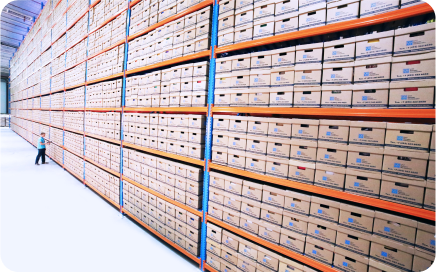5 Signs That You Need an Inventory System
By Rackbeat October 19, 2023

No matter how well your inventory-driven business is doing, you can always find a few areas within the inventory and order management that could benefit from a little optimization. Some of these might even constitute obstacles that hinder your business from reaching its full potential.
Fortunately, a bridge can be built to overcome most of the bumps associated with your inventory and order management.
For this article, I have compiled the most common challenges Rackbeat has solved for our users, allowing them to focus on development rather than irregularities in their workflows.
Whether you can relate to one or more of the following challenges, you can save a lot of time, effort and resources by implementing an inventory system in your operations. First, we will explore the 5 signs that indicate a need for an inventory system in your workflows, followed by the presentation of Rackbeat’s solutions.
Let’s start with a classic time-waster.
1. There is a lot of time spent on manual work
Every time a customer places a new order or a product moves from one place to another, you must record it in your spreadsheets or notepad to keep your inventory accurate. This steals your time and, at the same time, increases the risk of errors—no matter how sharp your mind is or how agile your fingers are.
Statistically, you make an average of 1 error every 300th keypress on your keyboard. This means you not only waste time when manually recording product movements but also risk creating confusion in your orders, purchases, and inventory statuses, leading to a loss of control over essential aspects of your business.
2. You lack reports on purchases, inventory, and sales
When it comes to your data on purchases, inventory statuses, and sales, you also lack comprehensive insights. This is because you are unable to generate comprehensive reports on orders, inventory levels, and sales orders when working with spreadsheets or systems that are not tailored to inventory management.
This puts you in a minefield with blindfolds on when it comes to ordering products. If you don’t base your purchases on real data, the risk of buying too few or too many items increases. Both scenarios are costly: either your customers encounter empty shelves, or you end up with excessive capital tied up in your inventory.
3. Your inventory is not integrated with your accounting and sales
One significant reason you spend too much time on manual data entry, over-order products, or encounter billing issues is that your accounting system and sales do not communicate with your inventory.
Therefore, there is no automatic notification to your inventory when a sale is made, for instance, in your online store, so that the products can be deducted from the inventory. You may also encounter obstacles when changes occur in your financial values. If a product needs to be written off because it’s damaged, or if you have some returned items from a customer, you have to manually update your inventory and create a credit note for your accounting system.
This breaks up your workflow into time-consuming segments because you don’t have an inventory system connected to your accounting and sales.
4. You spend a lot of time picking, packing, and shipping products
Speaking of disrupted workflows, there is room for improvement on the shop floor when it comes to overall order handling. Perhaps your employees lack an up-to-date overview of where the products are located in your inventory. It could also be that picking products is done manually or in a separate scanning system that is not connected to the inventory, resulting in a delay in inventory updates.
This affects the pace and efficiency of the entire order handling process.
5. The business depends on your PC or laptop for inventory updates
Another factor that can make your workflows cumbersome is if you work with an on-premise solution for your inventory management. In this case, you are forced to sit at a desktop PC or find the laptop where the system is installed whenever you need to update product registrations, inventory status, and sales orders.
If an employee is sick, the responsible person works remotely, or is on the move, another person cannot simply log into their device and handle inventory management.
You are therefore limited by the lack of a system that ensures inventory management and order handling never come to a halt.
Fortunately, there is such a system.
How Rackbeat Solves the 5 Challenges
You shouldn’t be burdened with challenges without also receiving their solutions. Rackbeat’s inventory management system enables you to turn these 5 pains into opportunities:
1. Eliminate time wasted on manual input and provide automation and oversight
In Rackbeat, your inventory movements are recorded every time a change occurs. When you make a sale, the inventory is automatically adjusted, reducing manual work and the risk of errors. You’ll always have a clear overview since you can access your inventory, sales, and purchase orders in easily digestible formats.
“Initially, we used what we call an Excel solution, which involved a lot of manual work, making it difficult for us to make sense of it all. Suddenly, there was a lot of data. But now, we simply put the product up for sale, and we can always follow up on orders in Rackbeat.
So, we have a system that tells us what we’ve purchased, sold, and have in stock. Writing it on paper makes it very confusing.” – Qais, DelsouX.
2.Eliminate data gaps and provide reports on purchases, inventory, and sales
With Rackbeat, you can generate reports on purchases, inventory levels, and sales. Having this data makes it much easier to make timely and informed purchasing decisions based on the frequency and speed of product sales over an extended period. With this knowledge, you can set minimum stock levels for each item in Rackbeat, and receive notifications when it’s time to reorder. This helps reduce capital tied up in stock and ensures your customers receive their orders on time.
“Now we can measure things. It’s great. We couldn’t do that before, but now we have data! We didn’t have the same data as we do now with Rackbeat.
That’s why we now have weekly sales meetings where we track what happened with different products, orders, and customers week by week through the data from Rackbeat.” – Thomas, Banana CPH.
3.Eliminate loose connections and provide integration between your inventory, accounting, and sales
Rackbeat can connect your inventory with your accounting system and webshop. So when a sale is made in your webshop or you create a sales order, the items are automatically deducted from the inventory, and you can send an invoice to your accounting system. If there’s a need for a return, you can adjust your inventory promptly. Should you encounter wastage, you can easily create a credit note sent to your accounting.
“The fact that Rackbeat could be integrated with e-conomic was quite important because we didn’t want to change our accounting system. I could also see that there were opportunities to integrate with webshops and a lot of other things.” – Christian, Dahl Limited.
4.Eliminate order processing obstacles and streamline your order flow
Rackbeat provides location management, allowing you to divide your inventory into multiple locations, rooms, shelves, and more. You can also access pick and pack lists directly from Rackbeat’s mobile app and connect the scanning system to inventory management. This significantly speeds up the picking, packing, and shipping of customer orders.
“Many of the tasks became much simpler because, in the past, we might have had to go through 8 steps, but now we can do it in 3 with Rackbeat. So, it’s clear that the time spent on these tasks can be significantly reduced, leaving more time for other things.” – Jorge, Melia Food Trade.
“When you create an order, you can also directly create a production for that order and link it to delivery notes, invoicing, and sending it to our external producers. In other words, with a single setup, you can get the entire chain going and close it at the same time.” – Thomas, Banana CPH.
5.Eliminate on-premises constraints and provide a cloud-based solution
Rackbeat is cloud-based, meaning your data is securely stored in the cloud. This allows all system users to access inventory and orders from anywhere, using any device, as the system is mobile-compatible.
“You can use Rackbeat on your phone or iPad. Our previous system didn’t allow that. It’s great that you can check your inventory on your phone and see inventory levels. It allows us to provide better and more accurate service. So, it helps our customers.” – Christian, MobileAdds.
Try Rackbeat Today
So you can indeed save a lot of time, typing errors and data loss with Rackbeat’s inventory management system. If you’d like to learn more about the system or seek solutions to other challenges, you’re always welcome to schedule a presentation with an inventory expert. You can also take the plunge and try the system for free for 14 days.



